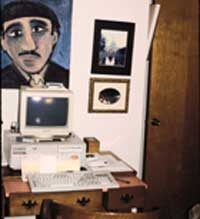 The room where this photograph hangs, blown up and framed, is what was once my brother's bedroom, an aspect of this space that I will return to at the end of this essay. For a long time now this room has functioned as an office. It is also a place where many of my father's prized first editions are kept, and where he composes his numerous editorials for the local newspapers. In addition to this, it is the place where my mother's computer resides. It is the office space where, together, my parents do their bills, and it is at this computer that my mother types up my father's handwritten editorials among the many other things she writes. In this respect this is her space. It is where she works.
The room where this photograph hangs, blown up and framed, is what was once my brother's bedroom, an aspect of this space that I will return to at the end of this essay. For a long time now this room has functioned as an office. It is also a place where many of my father's prized first editions are kept, and where he composes his numerous editorials for the local newspapers. In addition to this, it is the place where my mother's computer resides. It is the office space where, together, my parents do their bills, and it is at this computer that my mother types up my father's handwritten editorials among the many other things she writes. In this respect this is her space. It is where she works.
Even so, this room remains in certain respects my brother's bedroom. It is where he stays when he visits our parents. One of the two studio beds he had while growing up remains a part of the room and, although the original pine furniture has been replaced by a shelving unit, there is still a chest of drawers, a reminder that it was once a bedroom. Although these objects, furniture and technology mark this room in complicated ways, blurring the notion that the space is the exclusive domain of any single member of the family, I am most interested in the various pictures that mark this blurred space.
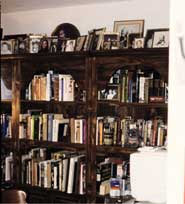 Focusing on the pictures that adorn the walls and surfaces of this one room tells a different story about my grandmother. Here her photograph is only one element in a larger, more complicated tableau. The array of pictures in this room is itself emblematic of the house as a whole where most of the walls and hallways and surfaces share the kind of excessive display. The difference is that in this room there is an overt connection between various other kinds of pictures and family photographs.
Focusing on the pictures that adorn the walls and surfaces of this one room tells a different story about my grandmother. Here her photograph is only one element in a larger, more complicated tableau. The array of pictures in this room is itself emblematic of the house as a whole where most of the walls and hallways and surfaces share the kind of excessive display. The difference is that in this room there is an overt connection between various other kinds of pictures and family photographs.
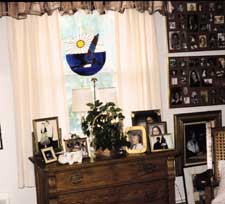 Given this, in what follows, I want to explore more fully what is here. This room is the space that not only connects me to the photograph of my grandmother
and some of its preoccupations but is the space in which the link between family photographs and other images become most apparent. The close proximity of
these photographs, collages, paintings and drawings makes explicit the preoccupations that animate all of these family pictures.
Given this, in what follows, I want to explore more fully what is here. This room is the space that not only connects me to the photograph of my grandmother
and some of its preoccupations but is the space in which the link between family photographs and other images become most apparent. The close proximity of
these photographs, collages, paintings and drawings makes explicit the preoccupations that animate all of these family pictures.
Like all of the other rooms in my parent's house, these walls are densely covered. There are virtually no blank spaces. It would not be an
exaggeration to call these walls excessive, exceeding what is normal or sufficient. What interests me is what this excess can tell us about the
people who live and work in this room. This former bedroom is the room where old family photographs are most fully on display. Framed images inhabit
every surface in the room. Family pictures fill the entire top of the prominent shelving unit as well as many of its shelves.4
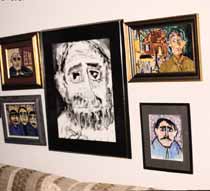 In addition to this, two late 1970s era collages of family photographs hang on one of the walls. High school graduation portraits sited within generations of family are at the heart of these collages assembled by my mother. In the first of these collages the largest images are graduation portraits of my brother and me. The second one focuses on my maternal grandmother's graduation portrait. Both collections include baby pictures of our parents, images of most of our grandparents, other close relatives, my mother's brother and his family and then snapshots of my immediate family and our dogs circa 1979.
In addition to this, two late 1970s era collages of family photographs hang on one of the walls. High school graduation portraits sited within generations of family are at the heart of these collages assembled by my mother. In the first of these collages the largest images are graduation portraits of my brother and me. The second one focuses on my maternal grandmother's graduation portrait. Both collections include baby pictures of our parents, images of most of our grandparents, other close relatives, my mother's brother and his family and then snapshots of my immediate family and our dogs circa 1979.
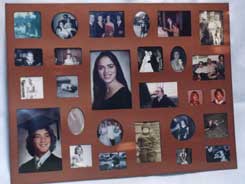 On another wall there are framed images from my first cousin's bat mitzvah and other framed images of the children of close family friends who have become a part of my family's greater chosen family. Although the photograph of my grandmother resides in this room, it is not really situated inside these familial displays.
On another wall there are framed images from my first cousin's bat mitzvah and other framed images of the children of close family friends who have become a part of my family's greater chosen family. Although the photograph of my grandmother resides in this room, it is not really situated inside these familial displays.
Her picture takes its place above the computer alongside other explicitly patriotic images. It is part of a wall unit that includes a nearly unreadable photograph of my parents at Bill Clinton's first inaugural ball in 1992.5 This is the Washington display, the space where the nation is literally brought home. Here the capitol and the president become a part of the family.
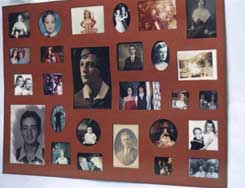 Alongside all of these framed photographs is a series of large paintings done by my father that claim the most space on the walls of this room as, in fact, his paintings claim the most space throughout my parents' house. For me these are the family pictures I know best. My father's art works, especially his faces, are the pictures I most associate with my family and with the places I call home.
Alongside all of these framed photographs is a series of large paintings done by my father that claim the most space on the walls of this room as, in fact, his paintings claim the most space throughout my parents' house. For me these are the family pictures I know best. My father's art works, especially his faces, are the pictures I most associate with my family and with the places I call home.